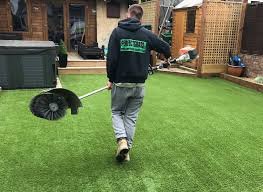Introduction
Tired of the hassle of traditional grass? Artificial grass offers a low-maintenance, beautiful alternative for your outdoor space. But before you dive in, it’s crucial to lay a solid foundation for your new synthetic lawn. This guide will walk you through the process of installing artificial grass over your existing lawn, ensuring a smooth and successful transformation.
Preparation: The Key to Success
Groundwork: The Foundation of Your Lawn
Before you even think about laying the artificial grass, you need to prepare the ground. Here’s what you’ll need to do:
- Check for Utilities: Before you start digging, locate any underground utilities like cables or pipes. Avoid damaging them at all costs.
- Drainage is Key: Ensure your area has adequate drainage to prevent waterlogging and potential damage to your new lawn.
- Remove Existing Grass: Use a turf cutter to remove the existing grass completely. A weed-free surface is essential for a long-lasting, weed-free lawn.
- Weed Killer: Apply a generous dose of weed killer to eliminate any remaining weeds and ensure a clean, weed-free surface.
Laying the Base: Building a Solid Foundation
- Weed Membrane: Install a weed membrane to prevent weeds from growing through your new lawn.
- Edging (Optional): If you’re planning to add edging around your lawn, install it now. Make sure it sits below the final grass line.
- Aggregate Base: Fill the area with type 1 aggregate to a depth of 60mm. Compact it thoroughly with a wacker plate.
- Sand Leveling: Apply a layer of sharp sand on top of the aggregate, using a screed bar to create a smooth, even surface.
Underlay: The Foundation for Your Artificial Grass
- Choose the Right Underlay: Select a high-quality underlay designed for artificial grass.
- Instalación: Roll out the underlay, ensuring it’s snug against the edges of your area. Cut it to the desired shape and secure it with jointing tape.
- Tacking: Place carpet tacks every 10-20cm to secure the underlay to the base.
Installing Your Artificial Grass
Laying the Artificial Grass: A Step-by-Step Guide
- Dry Day: Choose a dry day for installation. The base should be completely dry before you begin.
- Roll Out the Grass: Unroll the artificial grass onto the prepared area, leaving a 5cm margin around all edges.
- Settle Time: Allow the grass to settle for at least 2-3 hours. This will help the wrinkles disappear.
- Cutting and Trimming: Once settled, trim the grass to size, following the stitch lines.
- Joining Pieces: If you have a large area, you may need to join multiple pieces of artificial grass. Follow the instructions below for a seamless, professional finish.
Joining Artificial Grass: A Seamless Transition
- Direction Matters: Ensure the pile direction of each piece of grass is the same.
- Fold and Align: Align the edges of the two pieces, fold the edges back about 25cm, and expose the stitch lines.
- Cut the Stitch Lines: Cut 2-3 stitch lines down each edge.
- Seal with Joint Tape: Apply jointing tape to the seam, ensuring even pressure along the entire length.
Secure the Grass: Bonding for Durability
- Glue Application: Apply glue to the perimeter of the underlay. Work quickly, as the glue has a limited working time.
- Bonding Time: Allow the glue to bond with the underlay for at least two hours before walking on the lawn.
Sand and Brush: Finishing Touches
- Infill with Sand: Infill the artificial grass with kiln-dried sand. This helps secure the grass and prevents wrinkles.
- Brush for Perfection: Brush the sand into the grass fibers using a stiff broom. This will lift the fibers and create a lush, natural look.
Maintenance: Keeping Your Artificial Grass Looking Great
- Regular Brushing: Brush your artificial grass regularly with a stiff brush or a motorised broom to keep it looking its best.
- Debris Removal: Remove debris with a leaf blower, broom, or rake.
- Spillage Clean-up: Clean up any spills immediately with water.
- Heavy Objects: Avoid placing heavy objects or furniture directly on the artificial grass. Spread the weight to prevent indentations.
- Hot Objects: Keep barbeques and other hot objects away from the artificial grass.
Conclusión
Installing artificial grass can be a rewarding DIY project. By following these steps, you can transform your yard into a low-maintenance, beautiful oasis. Remember to choose high-quality materials and follow the instructions carefully for a long-lasting, beautiful lawn.
PREGUNTAS FRECUENTES
Q: How long does it take to install artificial grass?
A: The installation time depends on the size of your lawn and the complexity of the project. A small lawn can be installed in a few hours, while a larger lawn may take a full day.
Q: How much does artificial grass cost?
A: The cost of artificial grass varies depending on the quality, type, and size of the lawn. Expect to pay anywhere from $2 to $10 per square foot.
Q: How do I choose the right artificial grass?
A: Consider the climate, traffic, and desired look when choosing artificial grass. There are many different types of artificial grass available, each with its own unique properties.
We are a professional artificial grass manufacturer in China.We offer free artificial turf samples. If you have any questions about artificial turf, you can contact us at any time and our team will provide you with a site plan and quotation plan.

